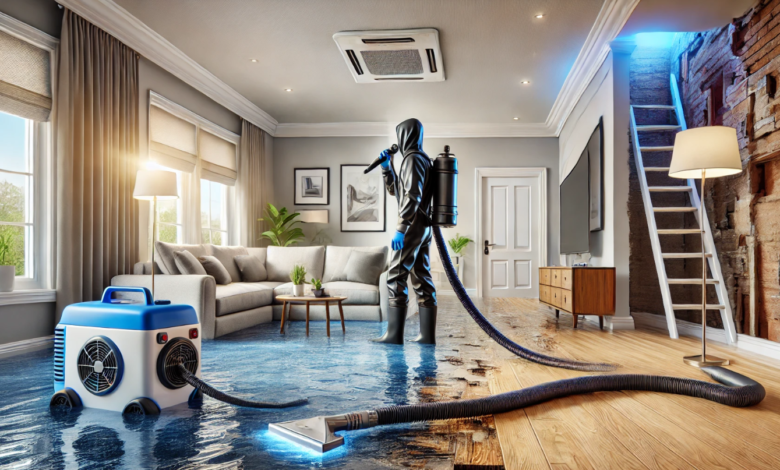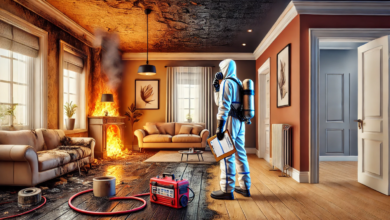
Water damage can happen suddenly and cause significant problems for homeowners. Whether it results from a burst pipe, heavy rainfall, or a malfunctioning appliance, the effects can be severe if not addressed immediately. Delays in cleanup can lead to structural deterioration, mold growth, and expensive repairs. Taking swift action is crucial to minimizing the damage and restoring your home effectively.
If you’re facing water damage Alexandria VA, prompt intervention is key to preventing further issues. Professional water damage cleanup specialists can assess the extent of the damage, extract excess moisture, and restore your property efficiently. This guide outlines the steps for effective emergency water damage cleanup and emphasizes the importance of professional restoration services.
Common Causes of Water Damage
Various factors can contribute to water damage, including:
- Burst or leaking pipes – Corrosion, freezing temperatures, or high pressure can cause pipes to fail.
- Severe weather – Heavy rain, storms, and flash flooding can overwhelm drainage systems.
- Roof leaks – Missing shingles or clogged gutters can allow water to seep in.
- Appliance malfunctions – Washing machines, dishwashers, and water heaters can develop leaks.
- Sewage backups – Blocked or overloaded sewer lines can cause hazardous overflows.
Addressing water damage promptly helps minimize long-term consequences and costly repairs.
Step-by-Step Guide to Emergency Water Damage Cleanup
1. Stop the Source of Water
Before any cleanup begins, identifying and stopping the water source is crucial.
- Turn off the main water supply if a pipe has burst.
- Seal roof leaks or repair plumbing issues.
- Call a professional if the issue requires specialized repairs.
Halting the water flow prevents additional damage and allows restoration efforts to begin.
2. Prioritize Safety
Water damage can create dangerous conditions, so safety should always come first.
- Shut off electricity in areas where water has reached electrical outlets or appliances.
- Avoid handling contaminated water from sewage backups, which may contain harmful bacteria.
- Use protective gear when dealing with standing water and debris.
If the damage is extensive, consider evacuating the home and waiting for professional assistance.
3. Remove Standing Water
Once safety measures are in place, water extraction should begin immediately.
- Use a wet/dry vacuum for small spills and minor flooding.
- Employ a sump pump to remove large volumes of water from flooded areas.
- Seek professional assistance for large-scale cleanup to ensure thorough moisture removal.
Quick removal of standing water helps prevent further property damage and speeds up the drying process.
4. Dry and Dehumidify the Space
Proper drying techniques are necessary to prevent mold growth and material deterioration.
- Position fans and dehumidifiers in affected areas to enhance airflow.
- Open windows and doors to improve ventilation when weather conditions allow.
- Inspect walls, flooring, and furniture for trapped moisture that could lead to long-term damage.
Professional drying equipment ensures deep water removal, reducing the risk of future structural problems.
5. Clean and Sanitize Affected Areas
Once the moisture is under control, the next step is disinfecting and salvaging materials.
- Apply antimicrobial cleaners to prevent bacteria and mold growth.
- Wash and dry textiles such as carpets, curtains, and upholstery.
- Dispose of severely damaged materials like soaked drywall or insulation.
A thorough cleanup process ensures a safe and healthy indoor environment after water damage.
6. Check for Mold and Structural Integrity
Mold can develop within 24–48 hours of water exposure. Signs of potential issues include:
- Musty odors or visible mold patches.
- Warped walls or flooring indicate lingering moisture.
- Softened drywall or weakened wooden structures suggesting long-term saturation.
A professional assessment can help detect hidden mold and prevent future problems.
7. Restore and Rebuild
Once cleanup and drying are complete, the final step is restoring your home.
- Replace compromised drywall, insulation, and flooring as needed.
- Repaint walls and refinish surfaces to restore the appearance of the space.
- Ensure that electrical and plumbing systems are fully operational.
Hiring professionals for this phase ensures a safe and effective restoration process.
Why Choose Professional Water Damage Cleanup Services?
Although some homeowners attempt DIY cleanup, professional restoration services offer significant advantages:
- Specialized Equipment – High-powered pumps, air movers, and dehumidifiers ensure efficient moisture removal.
- Mold Prevention Expertise – Experts use advanced techniques to eliminate mold risks.
- Insurance Assistance – Many restoration companies assist with claims and documentation.
- Faster Recovery – Trained professionals work quickly to minimize disruption and prevent secondary damage.
Hiring restoration specialists not only saves time but also ensures that your home is restored correctly.
Preventing Future Water Damage
Taking proactive measures can help reduce the risk of recurring water damage.
- Inspect plumbing regularly for leaks or deterioration.
- Maintain gutters and downspouts to direct water away from your foundation.
- Install a sump pump to protect your basement from flooding.
- Monitor appliances for leaks and replace aging hoses or connections.
- Seal foundation cracks to prevent moisture seepage.
Routine maintenance helps protect your home from unexpected water damage.
Conclusion
Managing water damage in Alexandria, VA requires prompt attention and expert care. By identifying the source, ensuring safety, extracting moisture, and conducting thorough cleanup and restoration, homeowners can recover efficiently. For a complete recovery, working with experienced water damage restoration Alexandria VA professionals ensures that every step is handled properly. Their expertise, equipment, and systematic approach provide peace of mind while safeguarding your home from long-term damage.



